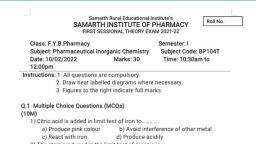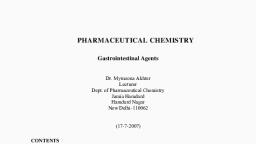Page 1 :
Unit ... 1, , LIMIT TESTS, , , , Limit = A value or amount that is likely to be present in a substance., Test = To examine or to investigate,, , Impurities = A foreign matter present ina compound,, , “Limit test is defined os quantitative or semi-quantitative test designed to identify and, control small quantities of impurity which is likely to be present in the substance. Limit test is, generally carried out to determine the inorganic impurities present in the compound”., , In short, limit test is nothing but to identify the impurities present in the substance and to, compare it with the standard,, , Importance of Limit test: ~, 1. To find out the harmful amount of impurities., 2. To find out the permissible/impermissible amount of impurities., , Experiment No. 01, , Aim: To perform the limit test for Chlorides of the given test sample., Requirements:, , (a) Glasswares: Nesslers' cylinder, measuring cylinder and glass rod., , (b) Chemicals: Dil. Nitric acid (10%), 0.1 M silver chloride, distilled water., , The chloride limit test is designed to determine the allowable limit of chloride present in, a sample., , Principle:, Limit test of chloride is based on the precipitation reaction. The precipitates of chlorides, develop on reaction of soluble chloride with silver nitrate in the presence of dilute nitric acid, , to form silver chloride, which appears as solid particles (opalescence) in the solution. The, intensity of turbidity depends on the amount of chlorides present in the test substance., , HNO, NaCl + AgNO; ———> AgCl + NaNO,, Reagent Preparations:, , * Dil. Nitric Acid: 106 ml conc. HNO; is diluted to 1000 ml with water., ® Silver Nitrate Solution: 5 g of AgNO; is dissolved in 100 ml of water., , , , 1, , , , Scanned with CamScanner
Page 2 :
A Practical Book of Pharmaceutical Inorganic Chemistry, , water,, , ° Test sample: ', , Y, , Limit Tests, , Standard Sodium Chloride solution: Dissolve 0.05845 g of NaCl in 100 ml distilleg, , (i) Dextrose: Dissolve 1 g in 10 ml distilled water to make the test sample., , (ii) Sodium Bicarbonate: Dissolve 1, , Procedure:, , g in 10 ml distilled water., , , , , , Test sample, , Standard compound, , Reasons, , , , , , Specific weight of compound/ test sample is, dissolved in water or, , solution is Prepared as, directed in the, pharmacopoeia and, transferred in Nesslers’, cylinder,, , Take 1 ml of 0.05845 %w/v, , solution of sodium, chloride in Nesslers’, cylinder., , hel, , a, , The aqueous solution will, leach out all the chloride ions, present in the sample and, make them. ready to react, with silver nitrate., , , , Add 10 ml of dil, nitric acid,, , Add 10 ml of dil. nitric, acid., , Dil. nitric acid is added in the, limit test of chloride to make, the solution acidic and helps, silver chloride Precipitate to, make solution turbid at the, end of process,, , , , Dilute to 50 ml in.Nesslers’, cylinder, , Dilute to 50 ml in Nesslers’, cylinder,, , For comparison of, , Opalescence, equal volume of, both is taken., , , , Add 1 ml of 0.1 M AgNO;, solution, stir properly and, keep aside for 5 min,, , Add 1 ml of 0.1M AgNO;, , solution, stir Properly and, keep aside for 5 min,, , The Ag* ions will react with , Cl ions to form Opalescence, Of silver chloride,, , , , , , , , , , , , Ag* + Ch —, AgCl, Observe the Observe the Compare after 5 min., Opalescence/turbidity, opalescence/turbidity, J, Conclusion:, , , , , , If opalescence produced in the sam, sample will pass the limit test of chloride, , and vice versa,, AAA, , 2, , ple solution is less than th, , € standard solution, the, , Scanned with CamScanner
Page 3 :
= Limit Teste, , , , A Practical Book of Pharmaceutical Inorganic Chemlstr, , Experiment No. 02 sta, a vamp, , , , Aim: To comy out tre Modled Chloride limit test of the given test substance,, Requirements:, , (a) Glasswares: Nesslers’ cylinder, measuring cylinder and glass rod,, , (b) Chemicals: Oi. Nitric acid. OM silver chloride, cone, HCL, distilled water., , is based on the precipitation reaction, The precipitates of chlorides, f so soluble chloride with silver nitrate in the presence of dilute nitric acid, lorie, which appears as solid particles (opalescence) in the solution, The, Vv we Sends on the amount of chlorides present in the test substance., , , , ference to International Pharmacopoeia 6" Edition 2016, the limit test of chloride, in the contert of standard solution preparation, Earlier the standard, , Was prepared by dissolving sodium chloride (NaCl, known Cl” impurity), n moditied by using hydrochloric acid (HCI) instead of sodium chloride, , , , Hcl + AgNO; —— AgCl + HNO;, , Hydrochloric Silver Silver Nitric, acid nitrate chloride acid, , Conclusion:, , IF opelescence produced in sample solution is less than the standard solution, the sample, , will pass the limit 7 of chloride and vice versa., AB Bo, , ‘Scanned with CamScanner






















































